Asta Powerproject:
Project Management Software
Project Management Software
Overview
It started with an unsolicited phone call. Would I be interested in looking at Asta Project Management Software. I would probably get ten offers a week to look at anything from new phone plans to listing in directories. This one sounded more interested so after talking with Michael for a while I asked if he could send me some information.
When it arrived, I was impressed. I decided that since I had never heard of the software, there were probably many other project managers out there who had never heard of it either. Whilst we don’t usually promote products through our white papers, I thought it a worthwhile exercise to publish a paper which will alert a few people to the existence of the software and if you are looking for a product, make some enquiries.
In putting this together, I would like to thank Michael Buddee, Karol Kot and Michael Cook from Solid Support in Sydney (www.solidsupport.com.au) for providing the information. Most of this white paper is plagiarised from the material they sent me.
Product Description
Asta is construction project management software. The key features that make it stand out from the opposition are:
1. Multiple Links Between two Tasks. This sounds like a technical feature but it is extremely important, in certain situations, in order to show the project end date accurately.
2. Interruptible Tasks. Another feature that is often required in order to show the project end date accurately.
3. Multiple Tasks per Row. Makes printouts smaller and more compact and models the processes of construction more elegantly and efficiently.
4. Resource Graphs and Histograms. Communicate plans and resourcing requirements more easily by showing multiple graphs and histograms of people, materials or finances underneath the bar chart – and print out on one piece of paper.
5. Detailed Progress Features. Show a task’s Planned % Complete. This lets you:
- Compare what should have been done with what has actually been done.
- More than one Progress Period can be created and data entered against each. This creates the most accurate ‘As Built’ plan which is often required to demonstrate how and why a project has arrived at its current position.
- Unlimited number of baselines. This is necessary if you need to record the status of a project each week.
6. Code Libraries. Enables you to filter out and group tasks based on their colour. Ideal for filtering out the work of a single contractor or various contractors/resources.
7. Ease of Use. Create links by drawing them – more intuitive and efficient, particularly for less experienced users. Pick up a group of tasks and move them. No hidden imposed dates – you have to explicitly set an imposed date.
8. Superb Quality Output. Surround the output with a four-sided graphical border. n Annotate the body of a plan with text including data derived from a task. Link the annotation to a task. Complete control over printed output.
9. Multiple Undos. Even after a reschedule. This is useful for testing out different scenarios.
10. Flexible Licensing.
- Named licence for standalone users.
- Concurrent licence for teams. Allows users to share licences.
- Enterprise licence for multi-user, real-time access to projects.
11. A free Viewer. Enables anyone to read, navigate and print out project plans created in Asta Powerproject version 5, 6, 7, 8, 9, 10 & 11, Asta Easyplan version 2, 3 & 4, Microsoft Project XML and Oracle Primavera XER and P3 file formats.
12. Data Import/Export. With Oracle Primavera, Microsoft Project and Asta software.
Multiple Links between Projects.
This simple, albeit rather technical, statement is extremelyimportant in demonstrating cause and effect of changes on a project and projecting the end date accurately. This requirement is important on all projects, but particularly where there is a contract between both parties and the result of changes can have a significant financial effect.
Consider the situation where two tasks can partially happen at the same time. If there is only one link between these tasks then a change of duration can have no effect on the end date, but if there are two links it should.

Asta Powerproject Start Asta Powerproject End
Similarly where a task is only restrained by one link and is partially progressed, the remaining un-progressed section can apparently have no effect on the end date, but if there are two links it should.

Asta Powerporject with partial progress
Interruptible Tasks
Modelling interruptible tasks correctly is important as it can affect the project finish date. Where a task restrained and two links exists, it is possible to consider stretching’ the task to allow it to start earlier while still having the same overall duration. This can result in the project taking place in a shorter time period. The ‘Foundations’ task is made ‘interruptible’ in Asta Powerproject, and this results in an earlier project finish date.
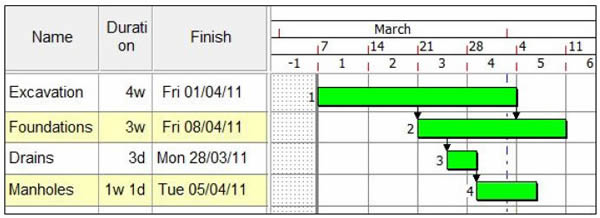
Asta Powerproject with ‘Foundations’ stretched and earlier project finish date.
Asta Powerproject can model this important situation, either by splitting a task into smaller parts and demonstrating the discontinuity effects of working this way, or it can keep the single task and show the overall result.

Asta Splitting Task
Asta Powerproject can accommodate more than one activity on the same row of the Bar Chart
This is particularly valued as it makes printouts significantly smaller and more compact. Also it is a familiar way of planning housing, procurement and finishing plans.

Asta Powerproject multi-task effect on a housing project

Asta Powerproject multi-task effect on the finishing stage of a project
Resource Graphs and Plans on same Screen/Page
Asta Powerproject allows you to have multiple graphs and histograms – of people requirements, materials or finances. This means that you can make edits to the plan and immediately see the impact on resources levels. Where you are trying to balance work for a limited resource it is essential to work in this way.
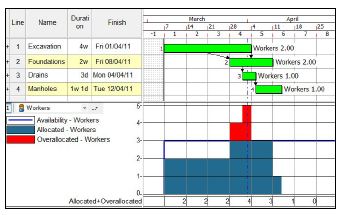
Asta Powerproject multiple graphs and histograms
Asta Powerproject lets you print out what you can see.

Print whatever you see on screen
In Asta Powerproject, graphs and histograms can also be printed out separately or their values exported directly to Microsoft Excel.
Progress
Recording the progress of a project is extremely important. Demonstrating the rate of progress and accommodating unforeseen situations while keeping the project on track (or minimising the impacts) is a principle requirement of project planning software.
- Asta Powerproject can show the value of a task’s Planned% Complete– i.e. how much shouldhave been done at a certain report date. This can of course be compared with what has been done to see where a project is ahead and behind schedule.
- The Progress Line (and Progress Shading) in Asta Powerproject can have its thickness, line type and colour defined. This means you can always make the Progress Line visible and not lost amongst other gridlines and links.
- More than one Progress Period can be created and data entered against each. This is important as you don’t just end up with an Actual Start and Actual End date, but a record of how the task progressed during eachProgress Period. This facilitates the most accurate ‘As-Built’ plan and it is often essential in demonstrating how and why a project has arrived at its current position. The actual cost, resource effort, task %- complete or EVA values per Progress Period can always be displayed and entered.

Asta Powerproject showing detailed ‘As-Built’ progress every week.

Asta Powerproject showing progress vales and shading every week.
- An unlimited number of baselines can be created in Asta Powerproject. This is often necessary to record the position each week during the course of a project. Should you be asked to show what the situation was like several months ago this can be an extremely useful facility.
- The progress from the live project can be imposed on the baseline to obtain a Jagged Progress view – where the end date is not changed.
Asta Powerproject showing progress effects applied to the baseline every week
Code Libraries – Colours, Filtering and Banding
Asta Powerproject provides a structured way to affect the appearance of tasks on the bar chart.
Libraries of ‘Codes’ for different circumstances (Work Package, Floor Levels, etc.) are created and each is assigned a colour/pattern and sort-order.
A code (or more than one code) is assigned to a task (via drag-drop or spreadsheet entry) and so the task changes colour. The colour code Legend is shown on printouts and the Bar Chart can be Grouped and Sorted by these Code Libraries. This provides an excellent coordination mechanism – as people can see which tasks belong to whom. It also allows all the work of a single contractor to be easily filtered out, or the work of various contractors or resources to be gathered together into an alternative structure.
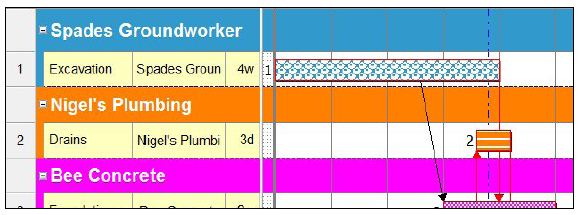
Ease of Use
The ease with which one piece of software can be used compared with another can be a subjective judgement, however in Asta Powerproject several tailored features do make it simpler and more accurate to use.
- You create links by drawing them from where they start to where you want them to end. You don’t have to enter the Link Type, nor the lead/lag value – all this is interpreted from where you start/end the link creation. This makes linking a project so much faster and less of a technical challenge for the less experienced planner when using Asta Powerproject.
- You can edit directly on the Bar Chart and the position of tasks will always be a whole number of time-units (of your choice).
- In Asta Powerproject any edit you do on one task can also be done to a group. So for example you can pick up a group of tasks and move them two weeks into the future.
- When you move a task in Asta Powerproject to another date this doesn’t set a hidden imposed date. In Asta Powerproject you have to explicitly set an imposed date.

Asta Powerproject context sensitive linking
Appearance on Screen and Output
The quality of output from any software system is an important consideration. This is because what you present to colleagues, clients and supply-chain partners is key to disseminating and communicating a plan.
- Surround the output with a standard Border – which is a four sided graphical header and footer standard that can be edited with a graphical drawing tool called PowerDraw. This places an attractive and standard frame around any output.
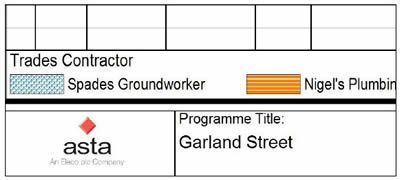
- The body of a plan can be annotated with text of any mixed font and include any data value derived from a task. Pictures and any other embeddable object, e.g. spreadsheets and movies, can be included.
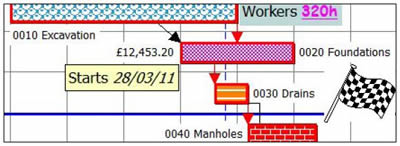
- Control the printing with a variety of features: fit to any number of pages – both horizontally and vertically; guaranteed to fill the whole page and not leave large white spaces depending on the aspect ratio of the output; set the number of rows to include on each page; switch On/Off various Legends as required and establish page breaks at regular and irregular intervals.
- The appearance of the plan can be controlled by turning any display feature On/Off – e.g. critical path marking, total and free float display, links, driving/nondriving links, etc.
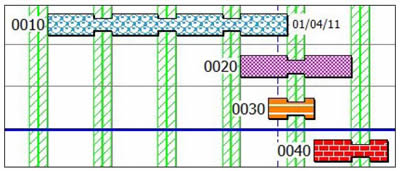
- Vertical and horizontal grid lines and coloured bands of various line types, colours and thicknesses can be created.

- The Date Zone at the head (and foot) of the plan can have up to ten rows. This can include project or annual week numbers. Changing the scale of the plan does not affect the type of information displayed in the Date Zone. The Date Zone is also used to graphically change the horizontal scale and various nonworking periods (e.g. weekends) can be omitted from the plan so that unwanted ‘dead’ space can be removed.
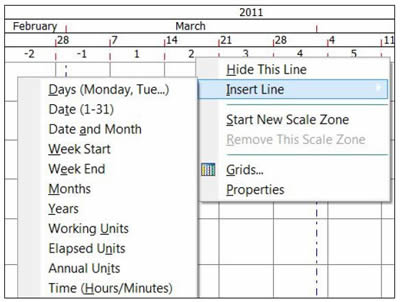
- The output can be sent to any Windows printer or PDF writer and various other graphic formats are supported that allow the whole plan to be pasted into other programs such as MS PowerPoint or MS Word.
- The logic link display shows the importance of each link at a glance and the logic of the plan can be navigated on screen so that you can easily understand the sequence of events.
Undo – even through a reschedule
Asta Powerproject has unlimited undo of any action – even of a reschedule or resource level.
Standalone and Concurrent Licensing – Plus the Free Viewer
Asta Powerproject has a flexible licensing policy.
- A free Viewer (known as Asta Project Viewer) is available for download from www.astadev.com/projectviewer so if anyone wants to examine, navigate or print out the plan they do not have to spend any money at all.
- A Named licence is available for an individual computer and can only be used on that computer. The licence can be transferred to any other computer (e.g. when you get a new laptop).
- A Concurrent licence is available where a counter (say a 2-user) is placed on a computer that all others can see. Asta Powerproject is installed on any number of computers (say 10) where the user may at some time want to edit a plan. Each installation points back to the computer containing the counter. When Asta Powerproject starts on a computer it checks that a spare licence exists at the counter and when you exit Asta Powerproject the counter is released. This arrangement makes the effective sharing of a licence amount a group of occasional editors and makes the cost of Asta Powerproject very cost effective.
Import/Export
Asta Powerproject has an excellent range of data formats that it can read/write to/from and allow data to be exchanged with various other project planning systems.
Asta Powerproject has an excellent range of data formats that it can read/write to/from and allows data to be exchanged with various other Project Planning systems. All calendars, resources costs, tasks, links and activity codes are exchanged (where the other system can support these features). This is sometimes needed as you might be interfacing with a client organisation that has another Project Planning system and they have a requirement to examine the basic data.
Data can be exchanged with: MPX (old MSP format), XML (newer MSP format), P3B (old Primavera P3 format), XER (newer Oracle Primavera P3e v5, 6 & 7 format), older versions of Asta Powerproject and Asta Easyplan.
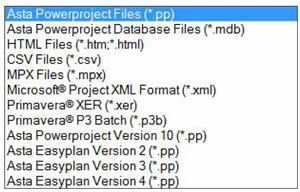
Service and Support
While software functionality is an important area for comparison when considering what software might be right for your organisation, the type of support you receive when you have bought the software is also important.
For example, when you have a deadline to meet (tender submission, monthly progress meeting, etc.) and you get stuck it is important to be able to pick up the phone and quickly speak to someone who can help you resolve any problem. The last thing you want is premium-rate phone calls or outsourced overseas call centres.
Asta operates:
An accessible and knowledgeable Help Desk where you can reach friendly and helpful people who can resolve any issue and offer guidance. Solid Support’s helpdesk is underpinned by expert in house planners.
- A number of Training Coursesto help people quickly climb the shallow learning curve and become effective operators of the system. Various courses are available on the web, at public courses in various locations around the country or inside your company.
- A Consultancy Servicewhere you can get advice before or after any implementation and commission bespoke program extensions (macros), reports and specialist data transfers.
Summary
As I said at the start, the content is drawn from documentation supplied by Solid Support who are a licensed Asta reseller in Australia. From an independent perspective the software does have some interesting features and is worth consideration if you are in the market for such a product. It would be interesting to hear some feedback on our blog from people who have used the software.
About Solid Support
At the core of Solid Support’s business is the preparation and ongoing maintenance of detailed critical path schedules using Project Management (PM) software, supported by 3D and 4D modellings, corporate training, software recommendations & helpdesk hotline for instantaneous phone support.
Solid Support Delay Analysis (SSDA) regularly undertakes detailed project analysis to determine the cause and effect of delay-related issues such as Extensions of Time (EOT) and variation claims.
Solid Support’s Quality Management System complies with the requirements of AS/NZS ISO 9001:2008.
Solid Support provide a full in house service offering from offices in Sydney Melbourne and the Gold Coast :
- Project Programme Management
- Asta Powerproject Software services
- Delay Analysis
- Corporate Training
- 3D and 4D modelling and CAD renders
- Software helpdesk
Contact Solid Support :
P : +61 2 9743 4666
E : info@solidsupport.com.au
Copyright Project Perfect
